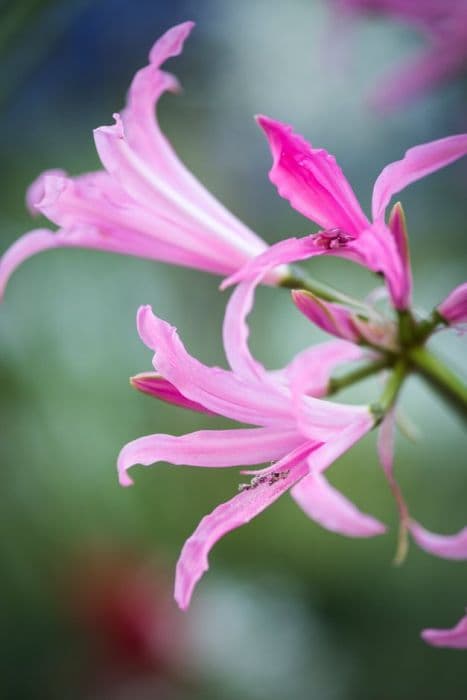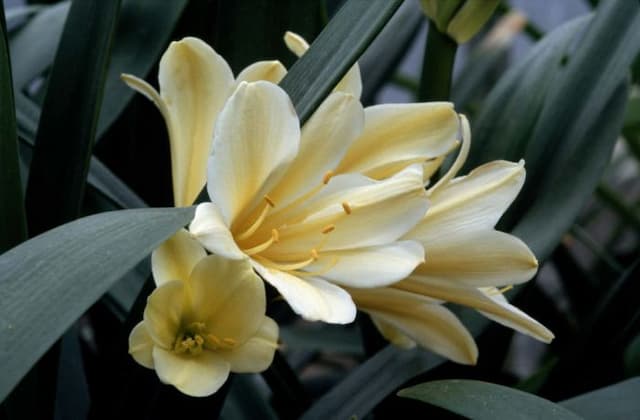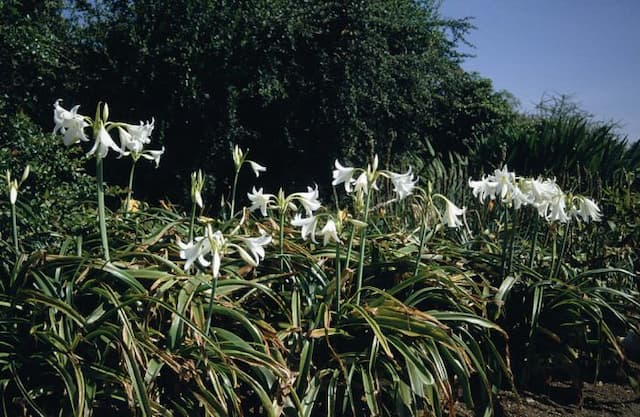Daffodil Narcissus 'Golden Dawn' (8)

ABOUT
Narcissus 'Golden Dawn' is a striking flowering plant known for its vibrant yellow blooms. The flowers have a daffodil-like appearance, characterized by a central trumpet-shaped corona surrounded by a ring of larger petals known commonly as the perianth segments. The petals are a rich, golden yellow color which spreads to the slightly deeper yellow crown, creating a sunny, cheerful display. The flowers typically grow in clusters, which adds to their eye-catching impact. The leaves are slender and long, with a deep green color that complements the bright flowers well. Overall, the plant has an elegant and uplifting presence in any garden, heralding the arrival of spring.
About this plant
 Names
NamesFamily
Amaryllidaceae
Synonyms
Golden Dawn Daffodil, Golden Dawn Narcissus, Jonquilla Narcissus Golden Dawn
Common names
Narcissus 'Golden Dawn'.
 Toxicity
ToxicityTo humans
Daffodil 'Golden Dawn' contains toxic alkaloids such as lycorine and other compounds that can cause poisoning if ingested. Symptoms of daffodil poisoning can include nausea, vomiting, diarrhea, abdominal pain, and possibly cardiac arrhythmias or convulsions in severe cases. Ingesting any part of the daffodil can lead to these symptoms, with the bulb being the most toxic part.
To pets
Daffodil 'Golden Dawn' is toxic to pets, including dogs and cats. Like in humans, the toxic alkaloids, primarily lycorine, can cause vomiting, salivation, diarrhea, convulsions, low blood pressure, tremors, and cardiac arrhythmias if ingested. Ingesting any part of the daffodil can be harmful, with the bulb containing the highest concentration of these toxins.
 Characteristics
CharacteristicsLife cycle
Perennials
Foliage type
Deciduous
Color of leaves
Green
Flower color
Yellow
Height
1-2 feet (30-60 cm)
Spread
0.5 feet (15 cm)
Plant type
Bulb
Hardiness zones
3-9
Native area
Europe
Benefits
 General Benefits
General Benefits- Aesthetic Appeal: The Narcissus 'Golden Dawn', commonly known as Daffodil, has vibrant yellow flowers that add a burst of color to gardens and landscapes.
- Spring Blooming: Daffodils are early spring bloomers, providing one of the first signs of the changing season and bringing cheer after a long winter.
- Easy to Grow: They are hardy and require minimal maintenance, making them an excellent choice for both novice and experienced gardeners.
- Naturalizing: Daffodils have the ability to spread and naturalize in an area, creating larger and more impressive displays over the years.
- Cut Flower Use: The flowers are long-lasting when cut, making them ideal for bouquets and floral arrangements.
- Deer and Rodent Resistant: Daffodils contain toxic alkaloids that generally deter deer, squirrels, and other rodents from eating them.
- Pest Resistance: They are not prone to major insect problems, ensuring that their blooms remain unspoiled.
- Symbolism and Tradition: Daffodils are a symbol of rebirth and new beginnings, often associated with spring festivals and celebrations.
 Medical Properties
Medical PropertiesThis plant is not used for medical purposes.
 Air-purifying Qualities
Air-purifying QualitiesThis plant is not specifically known for air purifying qualities.
 Other Uses
Other Uses- The daffodil 'Golden Dawn' can be used in companion planting to deter pests as rodents often avoid the area where they are planted due to their toxic properties.
- Daffodil bulbs can be used as a natural dye source, yielding colors from yellow to green depending on the mordant used in the dyeing process.
- Cut daffodils are known to release a substance that can shorten the lifespan of other flowers in mixed bouquets, so placing them alone in vases can help maintain a minimalist aesthetic.
- They can be used for educational purposes in schools and colleges during botany studies to demonstrate the plant's life cycle from bulb to flower.
- The daffodil's vibrant and early blooms can be used as bio-indicators of climate change, as shifts in blooming time may reflect changes in environmental conditions.
- Daffodils can be planted in artistic floral patterns and designs within lawns and parks for ornamental landscaping that shows creativity and seasonal interest.
- Their flowers are sometimes used in floral arrangements for seasonal festivals and celebrations, especially those heralding spring or in Easter decorations.
- Daffodil planting can be employed as a community activity to beautify urban areas and involve residents in local greening initiatives.
- Photographers might utilize fields of daffodils as a picturesque setting for photo shoots, particularly in the fashion or wedding industries.
- They may also serve as a natural method of soil erosion control, as their bulbs can help to stabilize soil on slopes during the rainy season.
Interesting Facts
 Feng Shui
Feng ShuiThe Narcissus, particularly the Narcissus 'Golden Dawn', is thought to bring good fortune in Feng Shui, especially when placed in the wealth corner of a home, which is the southeast area according to the Bagua map. Because it blooms in the spring, the Narcissus can also symbolize new beginnings and renewal, and placing it in the living room can usher in positive energy and encourage personal growth.
 Zodiac Sign Compitability
Zodiac Sign CompitabilityThe Narcissus is not used in astrology practice.
 Plant Symbolism
Plant Symbolism- Rebirth and Renewal: The Narcissus 'Golden Dawn', commonly known as daffodil, often blooms in early spring, symbolizing the end of winter and the arrival of a new beginning.
- Vanity and Self-Obsession: Named after the Greek mythology character Narcissus, who fell in love with his own reflection, daffodils can sometimes represent narcissism or excessive self-love.
- Prosperity and Wealth: Their bright, golden color is frequently associated with success and wealth, making them a positive symbol in various cultures.
- Uncertainty and Unease: In some contexts, daffodils can represent uncertainty or unease, as they can also be a foretelling of misfortune.
- Respect and Admiration: Presenting a daffodil to someone can signify deep respect and unrequited admiration, reflecting the sentiments of the giver.
- Inspiration and Creativity: As a herald of spring, daffodils inspire creative thoughts and artistic pursuits, celebrated during festivals and in poetry.
 Water
WaterDaffodils, such as the 'Golden Dawn', should be watered deeply once a week with about 1 inch of water, particularly during the growing season if there is no significant rainfall. This translates to roughly 0.6 gallons per square yard. Ensure that the soil drains well to prevent waterlogging, which can cause bulb rot. After flowering, you can reduce watering as the foliage begins to yellow and the plant goes dormant. Always water at the base of the plant to keep the foliage dry and prevent fungal diseases.
 Light
LightDaffodils like 'Golden Dawn' thrive in full sunlight, which means they need at least 6 hours of direct sunlight per day. They can also grow in partial shade but may not bloom as profusely. The best spot for these plants is in an area that receives morning sunlight and partial shade during the hottest part of the afternoon, especially in regions with very warm spring temperatures.
 Temperature
TemperatureDaffodils, including the 'Golden Dawn' variety, can tolerate winter temperatures down to about 0 °F, making them suitable for cooler climates. They perform best when the springtime temperatures range between 50 °F and 65 °F. The bulbs need a chilling period with temperatures below 50 °F for several weeks to trigger spring blooms.
 Pruning
PruningDaffodils, including 'Golden Dawn', do not require pruning in the traditional sense but deadheading spent flowers is beneficial. After blooming, remove only the flower heads to prevent seed formation. Leave the foliage in place until it has yellowed and withered, usually about six weeks after flowering, to allow nutrients to return to the bulbs.
 Cleaning
CleaningAs needed
 Soil
SoilDaffodil 'Golden Dawn' thrives in well-draining soil with a mix of loam, sand, and compost, ensuring good fertility and moisture retention without waterlogging. Maintain a soil pH of 6.0 to 7.0 for optimal growth conditions.
 Repotting
RepottingDaffodil 'Golden Dawn' bulbs should be repotted every 2 to 3 years, preferably after the foliage has died back, to allow for division and rejuvenation of the bulbs.
 Humidity & Misting
Humidity & MistingDaffodil 'Golden Dawn' prefers average to slightly below-average humidity levels, avoiding excessively moist environments which can lead to bulb rot.
 Suitable locations
Suitable locationsIndoor
Place in bright, indirect light and cool conditions.
Outdoor
Plant in full sun to part shade in fall.
Hardiness zone
4-9 USDA
 Life cycle
Life cycleNarcissus 'Golden Dawn', commonly known as daffodil, begins its life cycle as a bulb, planted in late summer or autumn before the ground freezes. The bulb remains dormant underground during the cold winter months. With the onset of spring, environmental cues like warming temperatures and increasing daylight trigger the bulb to sprout, sending up green shoots and leaves. Following this, the daffodil produces its iconic yellow trumpet-shaped flowers, usually blooming from late winter to early spring depending on the climate. After flowering, the plant enters a period of photosynthesis, during which the leaves collect sunlight to produce energy for the next year's growth. Eventually, the leaves yellow and die back as the daffodil enters dormancy once more, retreating into its bulb to wait out another summer and autumn until the next growing season begins.
 Propogation
PropogationPropogation time
Spring to Summer
Narcissus 'Golden Dawn', commonly known as daffodil, is most commonly propagated through division, a process typically done in the late summer to autumn. The preferred time for division is when the foliage has died back, which indicates that the plant has entered its dormant period, usually around late August to September in many climates. The method involves carefully digging up the clumped bulb clusters from the ground and gently separating them into individual bulbs. Each separated bulb, which should have its own basal plate and some root material, can then be replanted into well-draining soil at a depth three times the height of the bulb, ideally spaced 3 to 6 inches (approximately 7.5 to 15 centimeters) apart to allow for proper growth and bloom in the following season.









